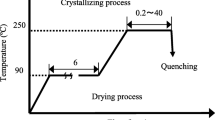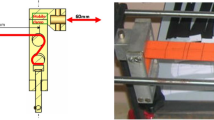Abstract
In this work, time and temperature-dependent viscoelastic properties, i.e., creep and stress relaxation of synthetic fabrics have been studied using the dynamic mechanical analyser. Three different fabric materials viz. polyester (PET), polypropylene (PP) and Nylon 6,6 (PA) were used and tests were carried out at a wide range of temperatures from 35 to 110 °C with an interval of 15 °C after each test. Thereafter, the master curve for each fabric is generated at 35 °C using the time–temperature superposition (TTS) principle which extrapolates short time experimental data to a longer time scale by shifting experimental curves of different temperatures toward the reference temperature (35 °C) and superimposes them to obtain a smooth master curve. From the creep study, it is observed that PET fabric is expected to give greater creep resistance with minimal deformation in creep strain of about 39% followed by 53% in PA and 128% in PP even after 10 years. Besides, in the stress relaxation study, relaxation modulus for all fabrics tends to decrease with increasing temperature. It is found that PA fabric showed a slow reduction of relaxation modulus even after 10 years, which gives about 55% reduction followed by PET (68%) and PP (75%) from its initial value. In addition, true stress versus time curves showed that a higher true stress value in PA followed by PP and PET is referring to its higher relaxation modulus. It was found that initial modulus, glass transition temperature (Tg) and crystallinity of fibre plays an important role in determining creep and stress relaxation behaviour of the fabrics. On the other side, the correlation between experimental data and theoretical data ascertains the use of viscoelastic Burger’s model and Weibull distribution equation model for creep and stress relaxation.













Similar content being viewed by others
Data availability statement
The data that support the findings of this study will be available on request from the corresponding author Dr. Mangala Joshi.
References
C.A. Lawrence, High-Performance Textile and Their Applications (2014), pp. 1–69. https://doi.org/10.1016/C2013-0-17069-9 (ISBN: 978-1-84569-180-6)
S. Grishanov, High perform, in Text Their Appl, 1st edn., ed. by C.A. Lawrence (Woodhead Publishing, London, 2014), pp. 1–69
K. Srinivas, Stress relaxation and creep of polymers and composite materials (Ahmedabad, India, 2020)
A. Asayesh, A.A.A. Jeddi, Text. Res. J. 80, 642 (2010)
G.D. Dean, Polym. Test. 30, 229 (2011)
P.A. Sopade, P. Halley, B. Bhandari, B. D’Arcy, C. Doebler, N. Caffin, J. Food Eng. 56, 67 (2003)
J. Capodagli, R. Lakes, J. Capodagli, R. Lakes, Rheol Acta 47, 777 (2008)
A.J. Ariza, M. Marjorie, M. Augusto, C.A. Costa, M.F. Costa, Polym. Test. 82, 106312 (2020)
C. Xue, H. Gao, Y. Hu, G. Hu, Polym. Test. 87, 106509 (2020)
R. Rafiee, A. Ghamarzadeh, Polym. Compos. 44, 1 (2023)
R. Rafiee, A. Ghorbanhosseini, Thin-Walled Struct. 151, 106714 (2020)
R. Rafiee, A. Ghorbanhosseini, Fibres Polym. 22, 222 (2021)
R. Rafiee, B. Mazhari, Constr. Build. Mater. 122, 694 (2016)
R. Rafiee, B. Mazhari, Compos. Struct. 136, 56 (2016)
R. Rafiee, A. Ghorbanhosseini, Compos. Struct. 254, 1 (2020)
D. Ionita, M. Cristea, C. Gaina, Polym. Test. 83, 106340 (2020)
X. Gao, H. Chen, S. Sun, Fibres Text. East. Eur. 1, 72 (2015)
Z. Xu, Y. Liu, B. Wang, J. Nucl. Mater. 557, 153215 (2021)
M.D. Nikolic, T.V. Mihailovic, Int. J. Cloth. Sci. Technol. 8, 9 (1996)
V. Urbelis, A. Petrauskas, A. Vitkauskas, Fibres Text. East. Eur. 4, 37 (2004)
V. Urbelis, A. Petrauskas, A. Vitkauskas, Mater. Sci. 11, 162 (2005)
F. M. Monticeli, H. L. Ornaghi, R. M. Neves, and M. Odila Hilário Cioffi, J. Strain Anal. 55(3-4), 109–117 (2020). https://doi.org/10.1177/0309324719892710
N. Lorandi, M. Odila Hilário Cioffi, C. Shigue, and H. L. Ornaghi, Mater. Res. 21(3), e20170768 (2018). https://doi.org/10.1590/1980-5373-mr-2017-0768
Dynamic Mechanical Analysis - Chemistry LibreTexts. Weblink: 2.10. (2018) https://chem.libretexts.org/
ASTM D5035—breaking strength and elongation of textile fabrics (Strip Method) (2019).
M. Dogan, A. Kayacier, Ö.S. Toker, Food Bioprocess Technol. 6, 1420–1433 (2013). https://doi.org/10.1007/s11947-012-0872-z
Y. Jia, K. Peng, X.L. Gong, Z. Zhang, Int. J. Plast. 27, 1239 (2011)
P. Hajikarimi, F. Moghadas Nejad, Applications of viscoelasticity (Elsevier, New York, 2021), pp.85–105
Y.F. Shutilin, Polym. Sci. U.S.S.R 33, 119 (1991)
D. Ljubic, M. Stamenovic, C. Smithson, M. Nujkic, B. Međo, S. Putic, Zast. Mater. 55, 395 (2014)
M.H. Zohdy, S.S. Mohamed, A.W.M. El-Naggar, Nucl. Instruments Methods Phys. Res. Sect. B Beam Interact. with Mater. Atoms 222, 105 (2004)
J. Wiener, A. Chládová, S. Shahidi, L. Peterová, AUTEX Res. J. 17, 370 (2017)
E. Kontou, Creep analysis of polymer matrix composites using viscoplastic models. In: Creep and Fatigue in Polymer Matrix Composites, 2nd edn., (2019), pp. 215–248. https://doi.org/10.1016/B978-0-08-102601-4.00006-0
J.W. Nicholson, The chemistry of polymers, second (The Royal Society of Chemistry, Cambridge, 1997)
R. Greco, L. Nicolais, Polymer 17, 1049 (1976)
Glass Transition Temperature of Polymers (2012). https://www.protolabs.com/resources/design-tips/glass-transition-temperature-of-polymers/
Glass Transition Temperature (Tg) of Plastics - Definition & Values (2014). https://omnexus.specialchem.com/polymer-properties/properties/glass-transition-temperature
R.M. Guedes, Polym. Test. 30, 294 (2011)
B.M.D. Fernando, X. Shi, S.G. Croll, J. Coatings Technol. Res. 5, 1 (2008)
H.L. Ornaghi, J.H.S. Almeida, F.M. Monticeli, R.M. Neves, Compos. Part C Open Access 3, 100051 (2020)
J.M. Choung, S.R. Cho, J. Mech. Sci. Technol. 22, 1039 (2008)
A. Rauh, R. Hinterholzl, K. Drechsler, Eur. Phyical J. Spec. Top. 206, 15 (2012)
Acknowledgements
The authors gratefully acknowledge the DRDO’s Lab Aerial Delivery Research and Development Establishment (ADRDE), Agra, India for sponsoring this project (RP03465G). The authors also acknowledge a joint venture between DRDO and IIT Delhi named Joint Advanced Technology Centre (JATC) for providing lab facility.
Author information
Authors and Affiliations
Corresponding author
Ethics declarations
Conflict of Interest
The authors declare no potential conflict of interest in relation with the research, authorship, and/or publication of this article.
Rights and permissions
Springer Nature or its licensor (e.g. a society or other partner) holds exclusive rights to this article under a publishing agreement with the author(s) or other rightsholder(s); author self-archiving of the accepted manuscript version of this article is solely governed by the terms of such publishing agreement and applicable law.
About this article
Cite this article
Mandlekar, N., Rana, B., Maurya, P. et al. Long-Term Prediction of Creep and Stress-Relaxation Behaviour in Synthetic Fabrics Using the Time–Temperature Superposition Principle. Fibers Polym 24, 2195–2207 (2023). https://doi.org/10.1007/s12221-023-00181-0
Received:
Revised:
Accepted:
Published:
Issue Date:
DOI: https://doi.org/10.1007/s12221-023-00181-0




